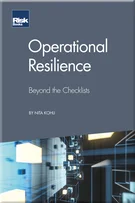Challenges and solutions: an auditor’s point of view
Joseph D Bielecki
Introduction
An overview of CECL: setting the context
Outlining the most impactful assumptions and challenges under CECL: an auditor’s view
Outlining the most impactful assumptions and challenges under CECL: a banker’s view
A banking industry perspective on key CECL decisions
Challenges and solutions for wholesale portfolios
Challenges and solutions for retail mortgage portfolios
Challenges and solutions for retail credit card portfolios
Challenges and solutions for student loans
Challenges and solutions for securities portfolios
The evolution of purchased loan accounting: from FAS 91 to the CECL transition
Challenges and solutions for qualitative allowance
Challenges and solutions: an auditor’s point of view
Early view of CECL integration into stress testing: practical approaches
Too many cooks in the kitchen: mastering the art of managing CECL volatility
Beyond CECL: rethinking bank transformation
Data collision: efficient lending under CECL
Cutting through the hype: how CECL is impacting investor views of procyclicality, credit analysis and M&A
Concentration risk: the CECL magnifying glass
Closing thoughts
It has always been challenging to audit an estimate, especially the allowance for bad debts (ie, the uncollectible portion of accounts receivables) or allowance for loan and lease losses (ALLL, ie, the uncollectible portion of loans). There is nothing concrete to tie the audit to: no market price, or even an industry standard valuation approach (such as the Black–Scholes pricing model). It is insufficient to merely verify that financial statements agree to the calculation, or that the data utilised in the calculation was complete and accurate. An auditor should also consider the methods and assumptions utilised in producing that estimate, the external (environmental) and internal information considered, and even the information that may not have been considered.
An auditor must develop an understanding of how management’s bias could have influenced the estimate. An auditor must understand the potential impact of any matter that is a matter of judgement. Very often, matters of judgement appear as an assumption that exists within a spectrum of potentially acceptable (or reasonable) outcomes. The challenge is often that these outcomes, which may each be reasonable, could result in
Copyright Infopro Digital Limited. All rights reserved.
As outlined in our terms and conditions, https://www.infopro-digital.com/terms-and-conditions/subscriptions/ (point 2.4), printing is limited to a single copy.
If you would like to purchase additional rights please email info@risk.net
Copyright Infopro Digital Limited. All rights reserved.
You may share this content using our article tools. As outlined in our terms and conditions, https://www.infopro-digital.com/terms-and-conditions/subscriptions/ (clause 2.4), an Authorised User may only make one copy of the materials for their own personal use. You must also comply with the restrictions in clause 2.5.
If you would like to purchase additional rights please email info@risk.net








